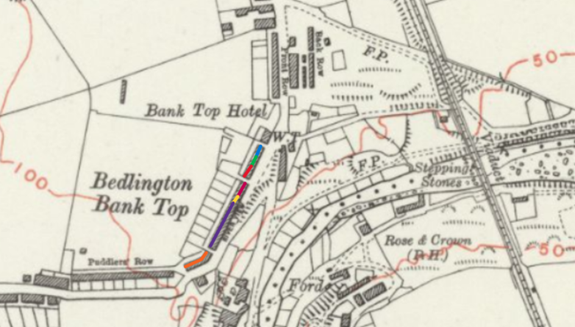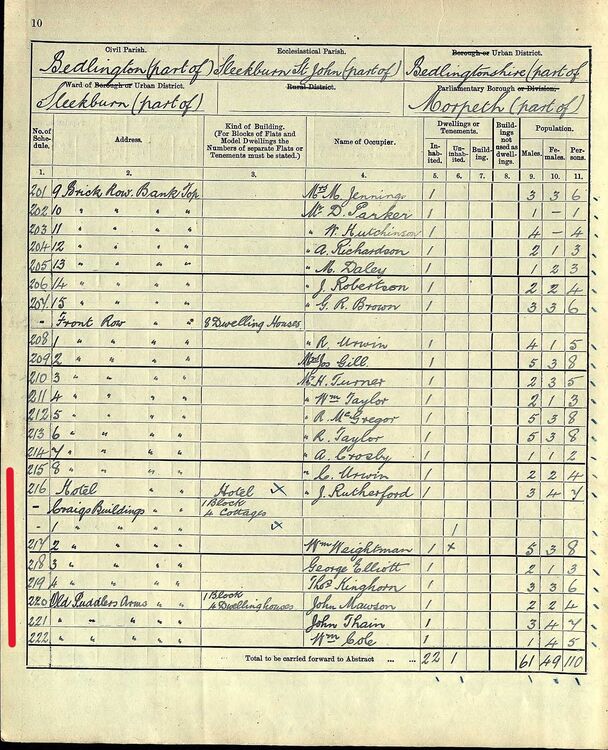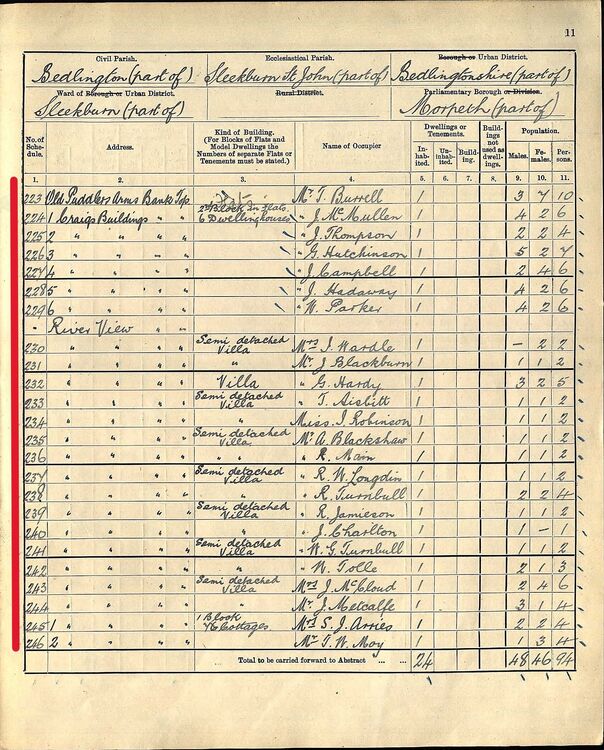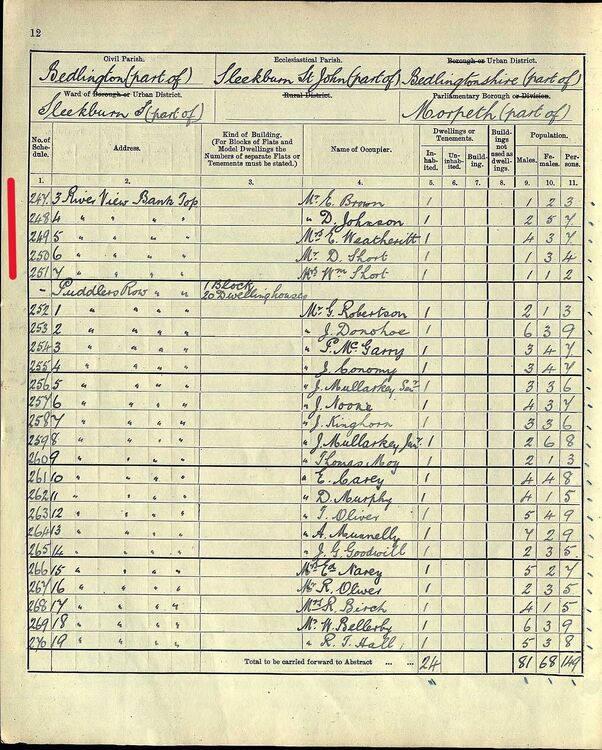Contributor Leaderboard
Popular Content
Showing content with the highest reputation on 14/04/25 in Posts
-
Make a cup of tea, there's no way of explaining this quickly! This may throw a little light on the mystery! The enumerator for Bedlington, District 9 in the 1911 census, was one J W Gaskin. He appears to have been a man who took his work very seriously. Going above and beyond the call of duty in meticulously recording the statutory requirements: name, age, birthplace etc. of each person he recorded even a brief description of the building in which the residents lived. From these descriptions I think its now possible to identify the buildings at Bank Top – at least in 1911. @loopylou Yesterday you described the census for 1911 in the following manner. (I’ve taken the liberty of colour coding your text so that I can compare them to census records, photos and maps. Unfortunately I can't use coloured text here). You said: “No. 1 Craggs (missing, a shop? Uninhabited?) BLUE No. 2 Craggs Buildings (Weightman) BLUE No. 3 Craggs Buildings (Elliott) BLUE No. 4 Craggs Buildings (Kinghorn) BLUE following these are Old Puddlers Arms (Mawson) GREEN Old Puddlers Arms (Thain) GREEN Old Puddlers Arms (Cole) GREEN Old Puddlers Arms (Burrell) GREEN All of these addresses ”Old Puddlers Arms” have two rooms each, which equates with the eight rooms described in the auction. then confusingly Craggs Buildings (no number) (McMullen) RED No. 2 Craggs Buildings (Thompson) RED No. 3 Craggs Buildings (Hutchinson) RED No. 4 Craggs Buildings (Campbell) RED No. 5 Craggs Buildings (Hadaway) RED Craggs Buildings (no number) (Parker) RED These also had two rooms each. Then after follows River View. It would appear that No. 2/3/4 are duplicated, but I do not think that these are the same properties, rather that the end six properties later become No. 9-14 of Craggs.” Let's ompare that with what the enumerator says. The enumerator describes the buildings these people lived in as follows: P 10: Sch nrs. 217 – 219 “Craigs Buildings, 1 block of 4 cottages” (1 unoccupied therefore only 3 sch. Nrs.) BLUE P 10: Sch nrs. 220 – 223 “Old Puddler’s Arms, 1 block 4 dwelling houses” GREEN P 11: Sch nrs. 224 – 229 “Craigs Buildings 2nd block in flats, 6 dwelling houses” RED There after follows River View starting with “a semi-detached villa, a villa, 6 more semi-detached villas and then 1 block 7 cottages”. If we transfer that information to a map (this one from 1924 as it’s the nearest I have) it looks like this: Following on from the red marking of Craigs Buildings, 2nd block, I’ve marked the enumerator’s description of River View: semi detached villa (pink), villa (yellow) and 7 semi-detached villas (purple), 1 block of 7 cottages (orange). If we then transfer that information to the 1930s photo it looks like this: There are a couple of questions that arise: The unmarked space between the blue marking and the green marking has no immediate explanation from the enumerator. I would suggest that it could be one of the 3 houses, each with four rooms, described in the 1864 advert as these are “adjoined” to the Puddler’s Arms. If this is the case then it should be marked BLUE. Much depends on the location of the outer wall of the Puddler’s Arms – to the right of or to the left of the unmarked space? In total, the three cottages have 12 rooms. The advert dated 1869 includes 6 double cottages of 2 rooms each. This also gives a total 12 rooms, so these could be the 3 roomed cottages mentioned in 1864. An alternative explanation for the space would be that it was occupied by the 2-roomed cottage offered for sale with the Puddler’s Arms in 1869 as part of the same lot for sale in 1869. If this is the case then it should be marked GREEN. To me it seems that, at least in 1911, the large building contained not only the public house (to the right) but also 6 flats (to the left). I’ve said before that housing was at a premium due to the need for a greatly increased workforce in Bedlington. Perhaps the Puddler’s Arms originally occupied the whole of the building but renting out accommodation may have given the opportunity to provide a better income – for infinitely less effort.2 points
-
1 point
-
It is certainly a mystery @Alan Edgar (Eggy1948)! Thank you for the info it is very helpful. Will have a look at those. I knew about Puddlers Row but was not aware that Glassey Terrace was formerly a Puddlers-related name too. 😄 One thing that confuses me is the way that Cragg’s Bdgs is labelled in the 1911 census. It makes it look like the Puddlers Arms is in the middle of the block and was later renamed to be part of Craggs. Rather than the Puddlers Arms being demolished and replaced with Bank Top Hotel. After Bank Top Hotel the addresses go as; No. 1 Craggs (missing, a shop? Uninhabited?) No. 2 Craggs Buildings (Weightman) No. 3 Craggs Buildings (Elliott) No. 4 Craggs Buildings (Kinghorn) following these are Old Puddlers Arms (Mawson) Old Puddlers Arms (Thain) Old Puddlers Arms (Cole) Old Puddlers Arms (Burrell) All of these addresses ”Old Puddlers Arms” have two rooms each, which equates with the eight rooms described in the auction. then confusingly Craggs Buildings (no number) (McMullen) No. 2 Craggs Buildings (Thompson) No. 3 Craggs Buildings (Hutchinson) No. 4 Craggs Buildings (Campbell) No. 5 Craggs Buildings (Hadaway) Craggs Buildings (no number) (Parker) These also had two rooms each. Then after follows River View. It would appear that No. 2/3/4 are duplicated, but I do not think that these are the same properties, rather that the end six properties later become No. 9-14 of Craggs.1 point

.thumb.jpg.7493ddab4a696108cf2b849323d3c155.jpg)




